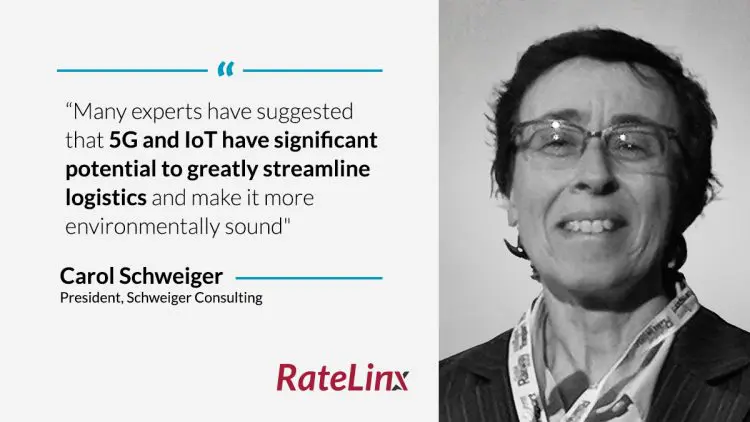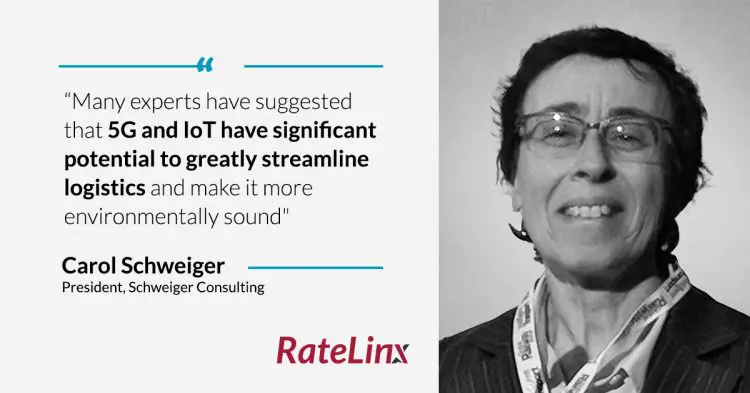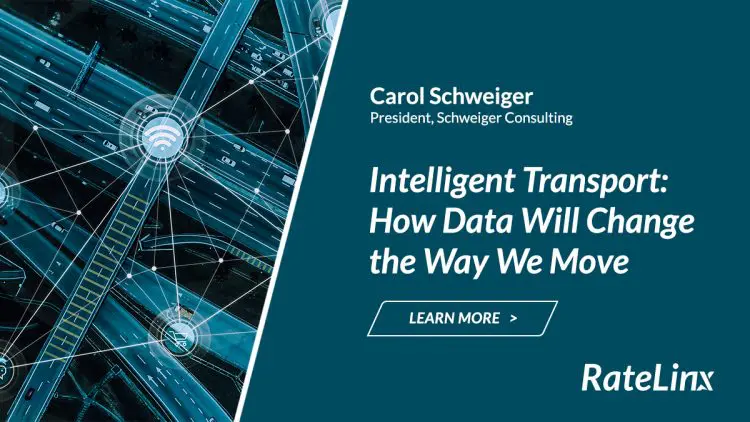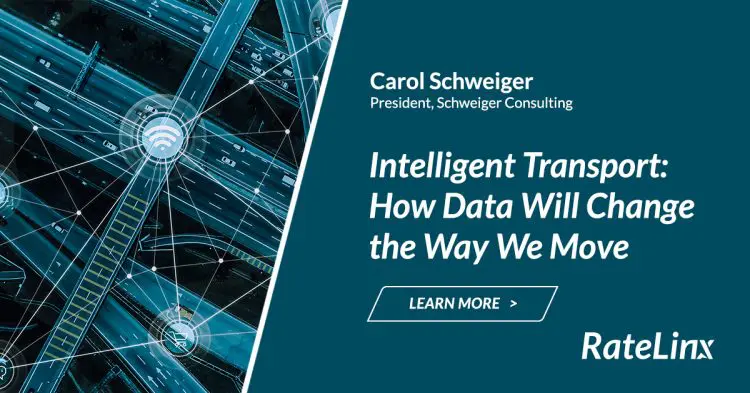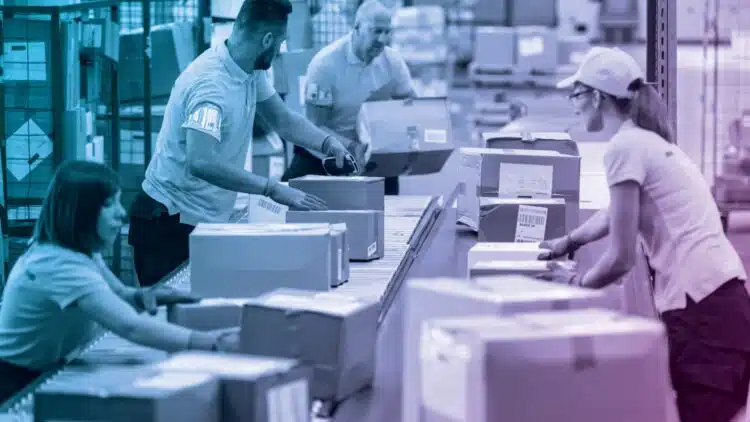Whether you’re moving cargo, people, or both, the nature of transportation is going to change drastically in the coming decade. We already see how IoT connectivity can bring more transparency and efficiency to the supply chain. Autonomous vehicles are just over the horizon as transportation data drives change.
According to Research and Markets, the smart transportation market is expected to reach $224.63B by 2024. This is an astounding Compound Annual Growth Rate (CAGR) of 18.68%.
Featured Expert

Carol Schweiger
Carol has spent the last 40 years of her career in transportation consulting, advising a broad range of transportation providers on how to adapt and evolve to meet future demands. Schweiger is nationally and internationally recognized in the area of Intelligent Transportation Systems (ITS) and Advanced Public Transportation Systems (APTS). Her wide-ranging and in-depth expertise is in several specialty areas including technology strategies for public agencies, public transit technology, traveler information strategies and systems, and systems engineering.
Carol is also the Co-Chair of TRB Committee on Innovative Public Transportation Services and Technologies and a member of the Stoneham Transportation Advisory Committee.
Recommended Reading:
We sat down with Carol to get a fresh perspective on how emerging technologies and transportation data will affect how we move people and products in the next decade.
What Is ‘Intelligent Transport,’ Exactly?
On the surface, ‘intelligent transport’ seems like a relatively innocuous term. But for industry experts, it’s one with far-reaching implications and almost clinical connotations.
“My definition of intelligent transport is the use of technology to facilitate the transportation of goods and people. While this is a very broad definition, it well describes the fact that technology provides the intelligence that makes it easier for people to travel and for goods to move,” Carol says. “Today’s elevator pitch often says the future of intelligent transport is shared, electric, automated, and connected. However, it must also be accessible, equitable, and inclusive in order to be considered intelligent.”
“Many experts have suggested that 5G and IoT have significant potential to greatly streamline logistics and make it more environmentally sound”
The Technologies Enabling Intelligent Transport
According to Carol, technologies like 5G and the Internet of Things (IoT) are already fundamentally changing the way we gather and refine transportation data.
“Most of the technology used in transportation includes a communication component. 5G will greatly improve the connectivity among travelers, technology-enabled mobility services, infrastructure, and vehicles,” she says. “What distinguishes 5G from its predecessors is that it will allow moving a lot of intensive computing to the cloud. This would make it possible for IoT sensors, used heavily in transport, communicate much faster.”
The potential of smart technologies to improve transportation efficiency and safety is so profound. We’re rapidly entering a future where transportation data is used to shape mobility initiatives and smarter city planning. Transportation insights even influence real-time decision-making.
“The primary benefits of IoT sensors to transport operators and authorities are more reliable data communication, being able to conduct on-board data collection and transactions in real-time, and supporting new mobility solutions, such as mobility as a service (MaaS),” says Carol. “Some suggest that ‘smarter’ infrastructure, such as that enabled by IoT, can provide feedback in real-time to influence traveler behavior and optimize system performance.”1
Technology Beyond Public Transportation Applications
According to Carol, the advantages of 5G and the IoT aren’t limited to public transport applications, either. These technologies also have broad prospects in the realms of supply chain and freight logistics — even unlocking new disruptive technologies.
“Many experts have suggested that 5G and IoT have significant potential to greatly streamline logistics and make it more environmentally sound,” she says. “There are three distinct changes due to 5G and IoT2: (1) better location tracking and route optimization; (2) continuous tracking with cheaper IoT sensors to avoid revenue leakage; and (3) enhanced communication and repairs through virtual reality (VR) and augmented reality (AR).”
For Carol, 5G and IoT are the building blocks for intelligent transport. The mortar holding them together? Artificial Intelligence (AI). She sees AI as the lynchpin for rapid innovation in how we move people (and products) more efficiently.
“In the US, we are seeing the largest public transport agencies devoting staff to innovation. AI, particularly in customer service, has significant potential in public transport,” she says. “An example is Transport for London’s (TfL’s) TravelBot, which started on Facebook at the end of 2017. It helps travelers monitor the status of the TfL services they are using in real-time and can answer simple questions.”
Like what you’re reading?
How Intelligent Transport Affects Over-the-Road Shipping
While Carol’s expertise is in public transportation, she has seen how transportation data in ITS will change how shipping works. There are several key areas of interest in which ITS can drive improvement:
- Collaboration – ITS can facilitate collaboration among supply chain entities.
- Safety – ITS can help to achieve the safety goals of shippers, particularly through automation.
- Sustainability – ITS can improve the sustainability of supply chains.
- Accountability – ITS can improve freight transportation accountability and help to move more toward Freight as a Service (FaaS)[2].
- Labor – While ITS can reduce labor in shipping, it can also increase the labor force specializing in new technology, such as the IoT and artificial intelligence.
- Financial impact – ITS can positively impact shipping due, in part, to reducing freight distribution costs as a result of increasing the productivity of freight delivery, improving the reliability of commercial vehicle operations, and increasing safety.
Autonomous Vehicles and Shipping/Supply Chain
With IoT technology and 5G well into the process of being rolled out, autonomous vehicles are still in testing (and in very limited test trials). But this technology will have a significant impact on intelligent transport in general and shipping in particular.
“Some of the technology necessary for fully-automated transport, beyond providing first-mile/last-mile service, is not yet available or currently under development.”
“Many logistics experts have described at least five impacts” of autonomous vehicles in over-the-road shipping, says Carol:
“(1) reduction in shipping costs due to decreases in labor and transportation costs; (2) opportunities for drivers with new jobs; (3) modification in the number and location of distribution centers (e.g., locating distribution centers closer to the end customer, possibly causing an increase in rent costs); (4) increase in road safety; and (5) reduction in the cost of “last-mile” delivery.”
These benefits aren’t without their drawbacks, however, says Carol: “There are also a number of possible challenges that could negatively impact shipping and supply chains. These include government regulations, legal risk, questions regarding liability and ongoing maintenance of the technology, including resident skillsets within the companies, whether shippers or logistics companies seeking to implement this capability.”[1]
Overall, however, the future looks bright for autonomous vehicles. The test case, says Carol, will be achieving first-mile/last-mile (FM/LM) autonomy as the gateway to more robust systems in the future.
Mastering FM/LM autonomy will pave the way for broad-ranging opportunities in autonomous transport. According to Carol, we’re still a long way off from anything concrete. She says, “some of the technology necessary for fully-automated transport, beyond providing FM/LM service, is not yet available or currently under development.”
The Future of Transportation
There’s no doubt that data is changing the way we move. From the IoT that collects transportation data to the 5G networks that relay it, to the AI that processes it, technology drives better solutions for the next iteration of public transit. In the hands of experts like Carol, this data becomes the means for advising truly intelligent transport — everything from MaaS initiatives to autonomous FM/LM solutions.
It’s crucial to realize that these aren’t far-off, leading-edge concepts of the future. For instance, they’re being tested, deployed, and refined in the public transit sector right now. As they find their footing, expect them to sidestep into freight and logistics, where there’s a veritable world of opportunity to move people (and products) with greater efficiency, adaptability, and oversight.
1 Iain Docherty, Greg Marsden and Jillian Anable, “The governance of smart mobility,” Transportation Research Part A 115 (2018) 114-125, page 118.
2 Dheeraj Remella, “Three Ways 5G Will Benefit the Logistics Industry,” Inbound Logistics, November 18, 2019, https://www.inboundlogistics.com/cms/article/three-ways-5g-will-benefit-the-logistics-industry/
